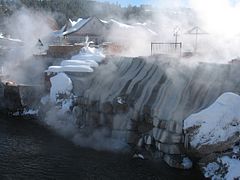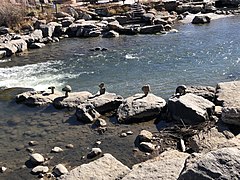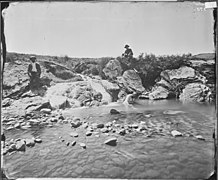
Archuleta County is a county located in the U.S. state of Colorado. As of the 2020 census, the population was 13,359. The county seat and the only incorporated municipality in the county is Pagosa Springs.

Pagosa Springs is a home rule municipality that is the county seat, the most populous community, and the only incorporated municipality in Archuleta County, Colorado, United States. The population was 1,571 at the 2020 census. Approximately 65 percent of the land in Archuleta County is either San Juan National Forest, Weminuche and South San Juan wilderness areas, or Southern Ute Indian reservation land.

The Western Slope is a colloquial term generally understood to describe the part of the state of Colorado west of the Continental Divide. Bodies of water west of the Divide flow toward the Pacific Ocean; water that falls and flows east of the Divide heads east toward the Gulf of Mexico. The Western Slope encompasses about 33% of the state, but has just 10% of the state's residents. The eastern part of the state, including the San Luis Valley and the Front Range, is the more populous portion of the state.

Beppu Onsen (別府温泉) is an extensive hot spring system in the city of Beppu, Ōita, Japan. There are eight distinct major thermal spring zones called "Beppu Hatto".

Sloquet Hot Springs is a hot spring 100 km (62 mi) south east of Pemberton and Whistler in British Columbia, Canada along the in-SHUCK-ch forest service road and is located in the traditional First Nations community of Xa'xtsa or Douglas First Nation in the community of Tipella, at 78.5 km (48.8 mi) along the in-SHUCK-ch forest service road.
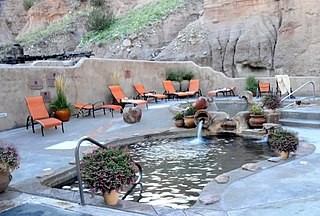
Ojo Caliente Hot Springs is a group of thermal springs located in Taos County, New Mexico, United States. They are also known as the Ojo Caliente Mineral Springs. These hot springs were used by native New Mexicans for many years. In the late 19th century the springs began to be developed for therapeutic use for several ailments, including tuberculosis.

Manby Hot Springs, also known as Stagecoach Hot Springs are thermal springs located near the town of Arroyo Hondo, New Mexico. The springs discharge into three rock pools with sandy bottoms located near the ruins of an old bathhouse and a historical stagecoach stop.

Verde Hot Springs is a grouping of thermal mineral springs near the town of Camp Verde in Yavapai County, Arizona. The springs are located at the western bank of the Verde River. There are ruins of a former historical resort at the site and bathhouse.

Mystic Hot Springs, previously known as Monroe Hot Springs and Cooper Hot Springs are located in northeastern Monroe, Utah. The hot mineral water emerges from the spring at 168 °F (76 °C). The water flows into two smaller pools with temperatures between 92 and 102 °F.

Chena Hot Springs are a system of thermal mineral springs located within the Yukon-Tanana Plateau near the town of Chena Hot Springs, approximately 50 miles northeast of Fairbanks, Alaska.

Baker Hot Springs are a system of geothermal springs located on Fumarole Butte, northwest of the town of Delta, Utah. The springs were formerly known as Crater Springs and Abraham Hot Springs.
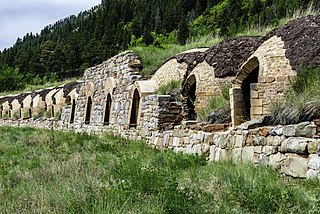
Penny Hot Springs is a geothermal spring located near the historic mining town of Redstone, Colorado.

Conundrum Hot Springs is a geothermal spring in a remote section of the Maroon Bells-Snowmass Wilderness area of the White River National Forest in Colorado Rocky Mountains.

Montezuma Hot Springs, also known as Las Vegas Hot Springs, are a grouping of 20-to-30 thermal springs in the Montezuma unincorporated community of San Miguel County, near the town of Las Vegas, New Mexico.
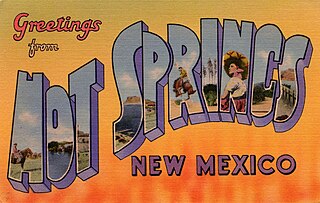
Truth or Consequences Hot Springs is a thermal spring system located in the Hot Springs Artesian Basin area of Truth or Consequences, New Mexico in Sierra County.

Yunomine Onsen is a hot spring system and resort town in Tanabe, near Hongu Town in southern Wakayama Prefecture, Japan. The Tsuboyu bath is located there, a UNESCO World Heritage site.

Gregson Hot Springs also known as Fairmont Hot Springs, is a geothermal hot spring system located in Silver Bow County, Montana. Over the years the mineral-rich hot spring water was thought to relieve rheumatism and arthritis among other ailments.

Mary Winter Fisher (1867–1928) was an American physician known for her establishment of a medical practice in Pagosa Springs, Colorado.
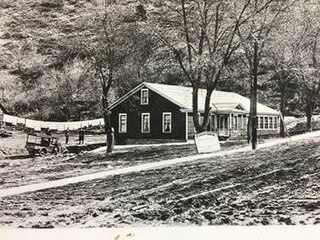
Wiesbaden Hot Springs is a group of three thermal springs and a vapor cave in Ouray, Colorado. The spring water flows from the source at 118 °F (48 °C) and is cooled to between 99 and 108 °F in the soaking pools.










